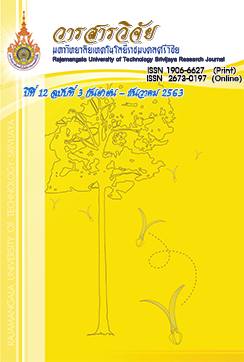Effect of Fungi on Physical and Nutrient of Compost from Oil Palm Frond (Elaeis guineensis Jacq.)
Keywords:
compost, fungi, degradation, oil palm frondAbstract
Microorganisms isolated from plant debris having properties to produce enzymes for plant degradation were applied in several agriculture. In this research, 2 fungal species of Trichoderma harzianum and Aspergillus niger which had previously been tested to efficiently yield cellulase and xylanase enzymes on the laboratory scale were used to produce the compost product. The objective of this research was to investigate the effect of fungi on the physical and nutrient of compost from oil palm frond. The experimental design using completely randomized design (CRD) with 4 replications and 5 treatments consisted of 1) T. harzianum 2) A. niger 3) T. harzianum with A. niger 4) microbial activators PD1 and 5) distilled water (control). Spore suspension of fungi adjusted to 1 × 108 spore/ml about 500 ml and combined with compost components was made up of oil palm frond : cow dung : urea at the ratio of 5 : 1 : 0.01 kilogram/bag. Then, they were left in the black plastic bag for 60 days. The results showed that use of T. harzianum mixed with A. niger gave the completed degradation and the best quality. The C/N ratio, pH, temperature and conductivity in compost were 14.44 : 1, 7.10, 27.53 oC and 3.91 dS/m, respectively while total nitrogen, phosphorus and potassium content in the compost were 2.15, 0.36 and 2.49 %, respectively. This compost being considered of good quality and standard and accredited by the Department of Agriculture should be promoted for further use.
References
Bernal, M.P., Alburqueruqe, J.A. and Moral, R. 2009. Composting of animal manures and chemical criteria for compost maturity assessment a review. Bioresource Technology 100(22): 5444-5453.
Boyce, A. and Walsh, G. 2007. Purification and characterization of an acid phosphatase with phytase activity from mucorhiemalis. Journal Biotechnology 132(1): 82-87.
Dickman, M.B. and Yarden, O. 1999. Serine/threonine protein kinase and phosphatasees in filamentous fungi. Fungal Genetic and Biology 26(2): 99-117.
Duff, S.M.G., Sarath, G. and Plaxton, W.C. 1994. The role of acid phosphatase in plant phosphorus metabolism. Physiology Plant 90(4): 791-800.
FAO. 2011. Oil palm fronds and oil palm crop residues. Food and Agriculture Organization of the United Nations. Available Source: http://WWW.feedipedia.
org/node.6916, February 28, 2020.
Gunnarsson, S. and Marstorp, H. 2002. Carbohydrate composition of plant materials determines N mineralization. Nutrient Cycling in Agroecosystems 62(1): 175-183.
Hartz, T.K. 2007. Assessing compost maturity and suitability for agricultural uses. Available Source: http://WWW.p2pay.org/ref /11/10513.html, February 28, 2020.
Huang, G.F., Wong, J.W.C., Wu, Q.T. and Nagar, B.B. 2004. Effect of C/N on composting of pig manure with sawdust. Waste Management 24(8): 805-813.
Kaewmorrakot, T. 2014. Production of Compost from Shallot Waste, Bone Meal and Goat Dung. Master Thesis of Soil resource management, Prince of Songkla University.
Kananum, W. 2009. Effect of Chicken Manure, Decanter sludge and Red Soil on the Oil palm Empty Fruit Bunches Composting. Master Thesis of Environmental management, Prince of Songkla University.
Khuna, S., Thongkled, K. Khitka, B. and Nuangmek, W. 2016. Effect of biodegrading fungal strains and composting time period on quality of water hyacinth compost. Songklanakarin Journal of Plant Science 3(suppl. 3): 1-7.
Land Development Department. 2020a. Soil managements data. Available Source: http://www1.ldd.go.th/ldd/Fertilizer/Organic_Fertilizer.pdf, February 29, 2020.
Land Development Department. 2020b. Soil Biotechnology. Available Source: http://WWW.ldd.go.th/ldd_en/en-US/mi crobial-activator-super-ldd-1/, February 28, 2020.
Meunchang, P. 2015. Research and development on biofertilizer, compost, organo-chemical fertilizer and agriculture decomposers production technology and analysis. Available Source: http://WWW. doa.go.th/research/attachment.php?aid=2214, March 1, 2020.
Meunchang, S., Panichsakpatana, S. and Weaver, R.W. 2005. Co-composting of filter cake and bagasse; by-products from a sugar mill. Bioresource Technology 96(4): 437-442.
Office of Agricultural Economics. 2020. Oil palm. Available Source: http://WWW.oae_report/production result.php, February 28, 2020.
Paekum, C., Khitka, B., Titayavan, M. and Nuangmek, W. 2014. Investigation of plant nutrient from water hyacinth compost by biodegradation with Trichoderma sp. isolate UPPY 19. Khon Kaen Agricultural Journal 42(Suppl.1): 671-676.
Palacios, M.C., Haros, M., Rosell, C.M. and Sanz, Y. 2005. Characterization of an acid phosphatase from Lactobacillus pentosus: regulation and biochemical properties. Journal Applied Microbiology 98(1): 229-237.
Sawangpanyangkura, T. 2012. Production of Compost. Wanida Printing, Chiang Mai.
Seephueak, P. 2012. Fungi Associated with Degradation of Rubber Wood Logs and Leaf Litter. Ph.D. Dissertation in Tropical Agricultural Resource Management, Prince of Songkla University.
Souza, A.A., Leitão, V.O., Ramada, M.H., Mehdad, A., Georg, R.D.C. and Ulhôa, C.J. 2016. Trichoderma harzianum produces a new thermally stable acid phosphatase, with potential for biotechnological application. Public Library of Science 11(3): 1-18.
Srimongkol, P. 2009. Screening of Microorganisms for Cellulase and Xylanase Production. Master Thesis of Science in Biotechnology, King Mongkut’s Institute of Technology Ladkrabang.
Vijuksungsith, P., Verasan, J., Kaewsuwan, U., Benjawan, L. and Boonprasert, R. 2016. Use of black plastic bags as container in composting process. Songklanakarin Journal of Plant Science 3(1): 56-62.
Walkley, A. and Black, I.A. 1947. Chromic acid titration method for determination of soil organic matter. Soil Science Society of America Proceedings 63(1): 251-255.
Wattanajira, L., Khamkong, K., Yudi, S. and Sanohiti, S. 2003. Aerobic composting from dry leaves and solid wastes. Thai Science and Technology Journal 11(1): 71-76.
Wongpankamol, P. 2006. Alternative: the efficiency of organic decomposition from residual vegetable and dry leaves by microbial activators for composting. Available Source: http://newtdc.thailis.or.th/docview.aspx?tdcid=41050, February 28, 2020.
Yamada, Y. and Kawase, Y. 2005. Aerobic composting of waste activated sludge: kinetic analysis for microbiological reaction and oxygen consumption. Waste Management 26(1): 49-61.
Downloads
Published
How to Cite
Issue
Section
License
The content and information in the article published in Journal of Rajamangala University of Technology Srivijaya It is the opinion and responsibility of the author of the article. The editorial journals do not need to agree. Or share any responsibility.







